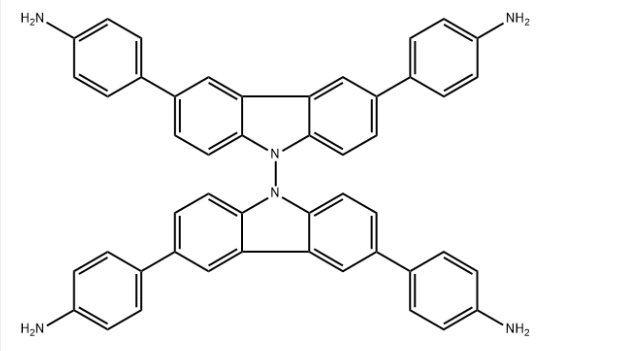BCTA-4NH2 CAS 2559708-42-6; ChemWhat Code: 1491293
Identification
| Product Name | BCTA-4NH2 |
| IUPAC Name | 4-[6-(4-aminophenyl)-9-[3,6-bis(4-aminophenyl)carbazol-9-yl]carbazol-3-yl]aniline |
| Molecular Structure |  |
| CAS Registry Number | 2559708-42-6 |
| Synonyms | 2559708-42-6 4,4′,4”,4”’-([9,9′-Bicarbazole]-3,3′,6,6′-tetrayl)tetraaniline 4,4′,4″,4″‘-([9,9′-Bicarbazole]-3,3′,6,6’-tetrayl)tetraaniline BS-53529 CS-0170121 G69855 4-[3′,6,6′-tris(4-aminophenyl)-[9,9′-bicarbazol]-3-yl]aniline 4,4′,4 ,4 ‘-([9,9′-Bicarbazole]-3,3′,6,6’-tetrayl)tetraaniline 4-[6-(4-aminophenyl)-9-[3,6-bis(4-aminophenyl)carbazol-9-yl]carbazol-3-yl]aniline |
| Molecular Formula | C48H36N6 |
| Molecular Weight | 696.8 |
| InChI | InChI=1S/C48H36N6/c49-37-13-1-29(2-14-37)33-9-21-45-41(25-33)42-26-34(30-3-15-38(50)16-4-30)10-22-46(42)53(45)54-47-23-11-35(31-5-17-39(51)18-6-31)27-43(47)44-28-36(12-24-48(44)54)32-7-19-40(52)20-8-32/h1-28H,49-52H2 |
| InChI Key | FCLCXBZRRFKRGK-UHFFFAOYSA-N |
| SMILES | C1=CC(=CC=C1C2=CC3=C(C=C2)N(C4=C3C=C(C=C4)C5=CC=C(C=C5)N)N6C7=C(C=C(C=C7)C8=CC=C(C=C8)N)C9=C6C=CC(=C9)C1=CC=C(C=C1)N)N |
Physical Data
| Appearance | Yellow to white powder |
Spectra
No data available
Route of Synthesis (ROS)
No data avaliable
Safety and Hazards
No data avaliable
Other Data
| Transportation | Store at 2-8°C away from light for long time storage |
| HS Code | |
| Storage | Store at 2-8°C away from light for long time storage |
| Shelf Life | 1 year |
| Market Price |
| Use Pattern |
| BCTA-4NH2 known as TAPC, is an organic compound with a wide range of applications. One of its primary uses is in the field of organic electronics, where it is used as a hole-transport material in organic light-emitting diodes (OLEDs) and organic photovoltaics (OPVs). In OLEDs, TAPC can act as a highly efficient hole-transporting layer, helping to improve the efficiency and stability of the device. It is particularly useful in the production of blue-emitting OLEDs, where its unique properties allow for improved performance. Additionally, TAPC can be used as a host material in the production of OLEDs, where it helps to enhance the luminance and efficiency of the device. In OPVs, TAPC can be used as a hole-transporting material in the active layer of the device. It has been shown to improve the power conversion efficiency of OPVs, making them a more viable option for renewable energy production. TAPC can also be used as a dye in the field of bioimaging, where it can be used to label and visualize biological molecules such as DNA and proteins. Its unique optical properties make it an excellent candidate for fluorescent labeling, allowing for precise detection and analysis of biological processes. |
Buy Reagent | |
| No reagent supplier? | Send quick inquiry to ChemWhat |
| Want to be listed here as a reagent supplier? (Paid service) | Click here to contact ChemWhat |
Approved Manufacturers | |
| WatsonChem Advanced Chemical Materials | https://www.watsonchem.com/ |
| Want to be listed as an approved manufacturer (Requires approvement)? | Please download and fill out this form and send back to approved-manufacturers@chemwhat.com |
Other Suppliers | |
| Watson International Limited | Visit Watson Official Website |
Contact Us for Other Help | |
| Contact us for other information or services | Click here to contact ChemWhat |

